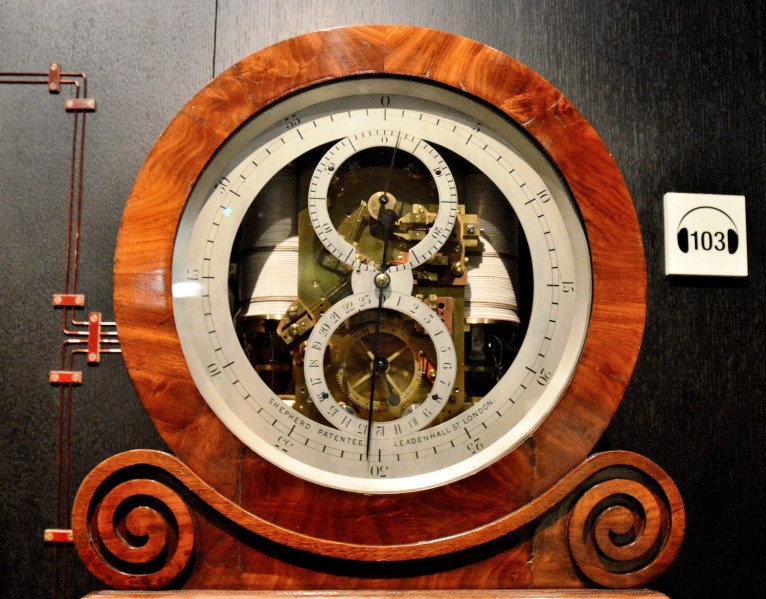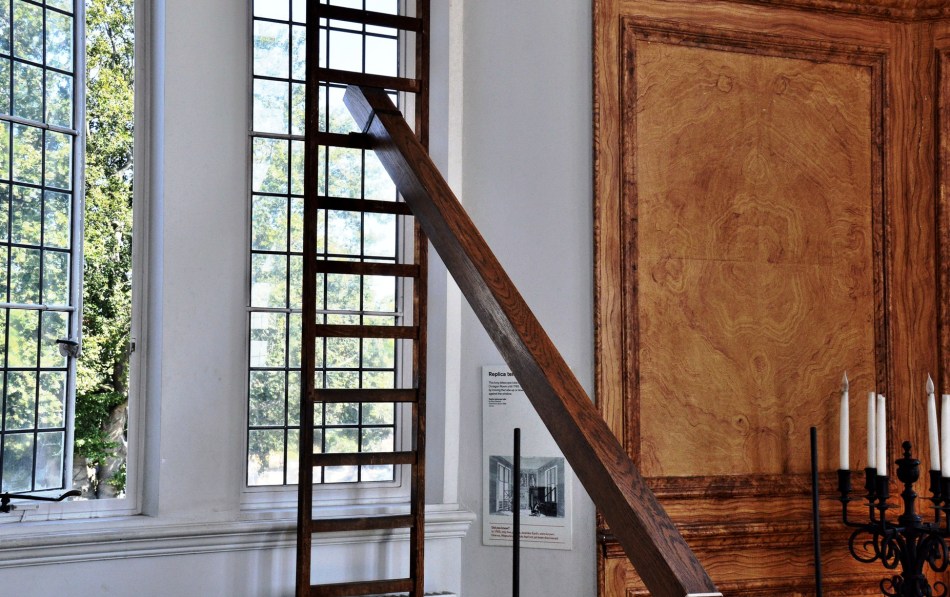Flamsteed House, The Greenwich Meridian and The Harrison Timekeepers

Statue of General Wolfe, the Great Equatorial Telescope, Flamsteed House and the Time Ball at Maritime Greenwich
All about Wonderful Greenwich and its many attractions is here ⇐.
One of the and most significant and greatest endeavours of human history has been the pursuit of navigational method at sea. It required the accurate measurement of astronomical observations and the development of a marine chronometer. The later being particularly difficult.
The Meridian Courtyard
The Meridian Courtyard is just in front of Flamsteed House, with the The Time Ball ⇒ on top. Here you can stand on the worlds east/west divide at 0 degrees longitude. Admission to Royal Observatory, Flamsteed House and the Meridian Courtyard is here ⇒.
However you can stand on the meridian for free where the red meridian line crosses an intersection in the paths in the park on the tourist map here ⇒.
The Meridian Line
There is usually a queue to stand astride the Meridian Line. This where the journey to east or west begins.
Inside Flamsteed House
Initially ones position, to the east or west of a starting point, could only be determined by dead-reckoning. That is, by measuring the distance traveled. At sea that meant measuring ones speed through the water. It was done by throwing a log overboard attached to a rope. The rope had knots at fixed intervals and the number of knots that were drawn out were counted for a fixed period of time using a sand glass. It was contrived so that one Knot was equal to one nautical mile per hour. A term that is still used today.
The dead reckoning method was woefully inadequate for long distances, no use for creating accurate charts and led to many disasters.
A better method required an accurate seagoing timekeeper. Such a timekeeper could be set to keep the time at a meridian. Greenwich was adopted and the time as Greenwich Mean Time (GMT). Wherever the ship was it would have the time at Greenwich. Therefore if at local noon the GMT timekeeper showed one o’clock the ship must be 1/24 of the way around the world. If the clock showed two o’clock then the ship must be 2/24 around the world etc and with every second that passed a smaller division. A fuller explanation and an extensive history of navigation can be found here ⇐.
After many years of effort John Harrison created the first maritime chronometer that would keep accurate time even on board a rolling ship.
The project began with H1 which was not accurate enough.
Neither was H2.
Neither was H3.
In 1759, after near 30 years of effort, Harrison created H4. This device had the advantage of advances in metallurgy, temperature compensation and the important realisation that a smaller/faster movement would be less effected by a ships movement.
There are more Antique Timepieces at the London Science Museum⇐.
And then:-
Mechanical Marine Chronometers can be as accurate as 5 secs gain or loss in fifteen days.
.
The first quartz clock was created in 1927 and worked by counting the electrically induced vibration of a piece of quartz. By 1969 a miniature version could be worn on ones wrist. Quartz chronometers can be as accurate as 0.7 seconds gain of or loss in 15 days.
A cesium (atomic) clock operates by exposing cesium atoms to microwaves until they vibrate at one of their resonant frequencies. They are accurate to within one second in 1,400,000 years.
The next generation of atomic clocks will keep time to one second in 15 billion years. At last the perfect boiled egg.
Back to some of the artifacts in Flamsteed House.

Freedom casket (contains the Freedom of London Scroll) presented to Sir George Biddell Airy (1801-92) Astronomer Royal, by the City of London in 1875
.
If you would like to know more about the development of navigation and its importance to our evolution it is here ⇐.
And, thank you for visiting Freed From Time (which isn’t as much of an anomaly as it sounds, probably 🙂 ).














Nice post – family tradition has it that I am descended from John Harrison – but I could not prove it. Did a lot of research
LikeLiked by 1 person
August 28, 2016 at 13:47
Thank you. It’s a bit of a hobby-horse for me.
As far as being descended from John Harrison, perhaps time will tell. 🙂 🙂
LikeLike
August 28, 2016 at 13:54
It’s problematic – and in Cudworth in Yorkshire
LikeLiked by 1 person
August 28, 2016 at 13:57
I hope it doesn’t wind you up. 🙂
LikeLike
August 28, 2016 at 14:03
no, not at all – spent 4.5 years writing family history in england, wales and poland and wrote thousands of pages
LikeLiked by 2 people
August 28, 2016 at 14:06
Did you see the film Longitude?
LikeLiked by 1 person
August 28, 2016 at 13:58
I did and thought it was well done.
LikeLiked by 1 person
August 28, 2016 at 14:02
Nostell Priory is a nice house too
LikeLiked by 2 people
August 28, 2016 at 14:03
Fascinated by old clocks and astrolabes, all the old measuring devices. Gorgeous old clocks and beautiful photos. You would like the Magellan Museum in Florence. I went by myself and spent all day there while my husband was climbing the Duomo.
LikeLiked by 1 person
August 28, 2016 at 20:04
I had no idea there was a statue of General Wolfe at Greenwich – I’m more accustomed to seeing him depicted like this: https://www.gallery.ca/en/see/collections/artwork.php?mkey=5363
LikeLiked by 1 person
August 28, 2016 at 21:51
There will be a close up of the statue later. It too has been in wars. The far side of the plinth bears the marks of shrapnel from WWII.
LikeLike
August 29, 2016 at 11:03
Graham, that gilded box with the blue-and-gold sun on the front is lovely.
LikeLiked by 1 person
August 28, 2016 at 21:52
I am glad you enjoyed. I forgot the caption, which is.”Freedom casket presented to Sir George Biddell Airy (1801-92) Astronomer Royal, by the City of London in 1875″.
LikeLike
August 29, 2016 at 11:05
Lovely shots. Those timepieces are exquisite.
LikeLiked by 1 person
September 1, 2016 at 16:15
A considerable effort of design and workmanship. Couldn’t be seen from the photograph but the larger ones were in motion. 🙂
LikeLike
September 1, 2016 at 19:08
You stood on the Meridian Line.. Was it like your brain was in two places at once 😉
LikeLike
July 21, 2017 at 23:18
These days, what’s left of my brain is not quite right. 😀
LikeLiked by 1 person
July 22, 2017 at 15:33
Not sure how to reply in a pc way here 😉 Just kidding!
LikeLike
July 22, 2017 at 18:26
I’m only kidding/punning myself. I’ve outraged people with rhyming Haiku. Oh the shame. 😀
LikeLike
July 22, 2017 at 21:00
Very impressive 🙂 great photos. I saved this site to not forget.
LikeLike
October 21, 2017 at 23:04
I am glad you find it useful. There will be more in future.
LikeLike
October 22, 2017 at 12:33